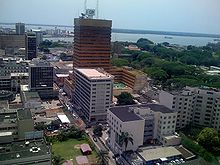ENCHANTÉ’S PICTURE ALBUM-IV, MORE OF AFRICA

Woman in Kenya
Sorry that ENHANTÉ had to be away for a while due to a surgery in the house, but we are back alive and kicking with more of Africa. Why? Because it’s so big and so intensely fascinating.
Let’s start with that EQUATOR! Learning geography in secondary school, I never dreamt of experiencing being at the Equator. A picture of my dad drew my curiosity even more.

This picture was taken near Pekanbaru on Sumatra. Dad was selling his world’s best Van Vollenhoven’s Beer in what then was the Dutch Indies, now Indonesia.

I followed suit at an “Equator” boot set up in Burundi, reportedly to commemorate the meeting of Stanley and Livingstone in 1871 about ten miles south of Bujumbura.
Côte d’Ivoire (Ivory Coast)
I worked on Côte d’Ivoire from 1985 to 1987, definitely one of the most intriguing periods in my World Bank life. The country was led by Président Houphouët-Boigny (nicknamed “Le Vieux”), a remarkable personality. In the early nineteen-eighties, he designated Yamoussoukro as the capital of Côte d’Ivoire, instead of Abidjan. Yamoussoukro was his birthplace. The village was previously called N’Gokro and renamed after Queen Yamousssou who was in charge of N’Gokro at the time of the French colonization. ‘Kro’ means ‘village’ in the local language.
Houphouët was assisted by a French “Technical Assistant” not less illustrious than him: Antoine Cesareo, a gifted and powerful civil engineer, born in Tunisia, who became the Director of the General Directorate of Large Works, and with whom we dealt in all our transport and urban works projects financed by the World Bank. He was, among others, the supervisor for the construction of the Basilica of The Notre Dame in Yamoussoukro, a prime project undertaken by Houphouët. It is reportedly larger than the St. Peter in Rome (which caused friction with the Pope) and cost a fortune that superseded by far the Ivoirian budget. The cost became a bone of contention with the donor community, in particular the IMF and the World Bank, but if it had not been for Cesareo, it might have cost even more. I only saw the leveled construction site (looked like two football fields). It was completed in 1995. It has a capacity for 18,000 followers, but as a rule, less than 1,000 attend the mass on Sundays.

photo credit: Felix Krohn
Another interesting feature of Yamoussoukro was Houphouët’s palace. The whole family lived there. Reportedly he himself lived modestly only in a small part of the building.

More interesting were the crocodiles that populated the groove along the palace. They were a gift from the President of Mali (Côte d’Ivoire has no crocodiles) and were fed fresh meat every day. Once a gardener got too close, got caught and was devoured.

I took this picture in 1985 when Antoine Cesareo accompanied us to Yamoussoukro.
Yamoussoukro housed a huge hotel – also handled by Cesareo – and several other buildings, among others an engineering institute, all generated with the overview of Cesareo’s “Grands Travaux.”

Below a picture of the formidable Cesareo, signing off on an urban project we had negotiated with him and his staff (all French) in 1986. The great Cesareo oversaw personally most of the civil works, roads and other infrastructures in Côte d’Ivoire and became the major cost cutter and anti-corruption activist.

The amusing aspect – for me as a Dutchman – was that Houphouët insisted on French technical assistance helping him govern Côte d’Ivoire as he had no confidence in his African civil servants. French being the French – including the World Bank staff on my teams – frequently had loud arguments among each other, defending the service they were assigned to, the African staff just looking on, stone-faced. Even while negotiating in Washington – and Cesareo was a shrewd and tough negotiator – I had to calm down the French ‘shouting matches.’

I am signing off on our negotiating results on an urban development project with my good friend François Amiot looking on.
These particular negotiations lasted a whole week till late in the evenings. The last evening, while we were battling the final conditions of the agreement at 10 PM, it had kept snowing heavily over the Washington D.C. area. We didn’t know, but many commuters traveling home got stuck on the highways and had to abandon their vehicles. It was complete chaos. When we finished, our Ivorian guests could not find a taxi. Cesareo and his staff had to walk to their hotel in the deep snow. Cesareo on his black pumps! He was not amused, as we heard. I remember driving home that night to Alexandria on a deserted 395, lined with hundreds of abandoned cars.




Left, a glimpse of Hotel Ivoire (Intercontinental) in Abidjan Cocody where I often stayed. The next three pictures show the Golf Hotel located at the Abidjan Lagune. From its beach, I could watch the contours of Abidjan where I had worked during the day (shown below). When I stayed there in 2001 on a consulting assignment with the African Development Bank, Gbagbo overthrew President Konan Bedié who, in the early nineties, had been selected by Houphouët to succeed him (over Wattahara, who had been running the Government during Houphouët’s last days). I had to ‘evacuate’ hotel Golf in haste – with dead bodies in the streets – and could just catch the last Air France before the airport was closed. Gbagbo threw the Ivory Coast into utmost disarray for ten years until Wattahara (a former IMF Director) was finally elected to put Ivory Coast back on its feet.


Much of what you see above are state-of-the-art works overseen by Cesareo.


Above a few pictures of Côte d’Ivoire’s lovely beaches where one could spend the weekends, eat the best lobsters freshly picked from the sea, and watch Ivoirian parties with fanciful ladies dancing the booty.
Next time Cameroon